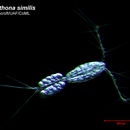Biology
provided by Arctic Ocean Biodiversity 2011
The most abundance surface-dwelling copepod of Arctic
- license
- cc-by-nc
- copyright
- Arctic Ocean Diversity
Comprehensive Description
provided by Arctic Ocean Biodiversity 2011
Body almost completely transparent, red tinting may be present on female urosome (the tail); Lipid sac can be prominent; Urosome (tail) long (40-50% of prosome); Antennae longer then prosome, but less than total length
- license
- cc-by-nc
- copyright
- Arctic Ocean Diversity
Habitat
provided by Arctic Ocean Biodiversity 2011
Boreal to arctic waters; Bipolar; Abundant on shelves, as well as over deep basins
- license
- cc-by-nc
- copyright
- Arctic Ocean Diversity
Life Cycle
provided by Arctic Ocean Biodiversity 2011
Females spawn year-round, less in winter; Female carries eggs in 2 elongate clutches until hatching; Clutch size dependent on size of female, with maximums of ~30 and typically ~15-25 eggs; Generation length unclear, suggested as 1 year for Arctic and multiple generations per year in the sub-arctic; Life expectancy uncertain
- license
- cc-by-nc
- copyright
- Arctic Ocean Diversity
Trophic Strategy
provided by Arctic Ocean Biodiversity 2011
Microcarnivore feeding on motile phytoplankton and protists, plus copepod nauplii
- license
- cc-by-nc
- copyright
- Arctic Ocean Diversity
Diagnostic Description
provided by iArczoo
Can be distinguished from O. atlantica by smaller size, structure of the rostrum and significantly shorter caudal setae.
- compiler
- Ershova, Elizaveta
Distribution
provided by iArczoo
Cosmopolite, but cold Atlantic waters are preferable locations
- compiler
- Ershova, Elizaveta
Ecology
provided by iArczoo
Oceanic, epi- to bathypelagic species
- compiler
- Ershova, Elizaveta
Morphology
provided by iArczoo
Female:
Rostrum is directed down, is only visible from lateral view. Caudal setae are never longer than the abdomen. Eggs inside egg-sac are usually placed in 1 row. Md endopodite with a small seta and 3 setae subequal in length. 2nd endopodal segment of Mx1 present and armed with 1 seta; 1st lobe represented by 1 seta
Male:
Rostrum is absent. Both A1 are geniculate. The caudal setae are significantly shorter than in female.
- compiler
- Ershova, Elizaveta
Size
provided by iArczoo
Female: 0,68-1,20 mm
Male: 0,50-0,82 mm
- compiler
- Ershova, Elizaveta
Distribution
provided by World Register of Marine Species
Arctic to Cape Cod
North-West Atlantic Ocean species (NWARMS)
- license
- cc-by-4.0
- copyright
- WoRMS Editorial Board
Habitat
provided by World Register of Marine Species
upper and glacial epipelagic regions of the Gulf and estuary
North-West Atlantic Ocean species (NWARMS)
- license
- cc-by-4.0
- copyright
- WoRMS Editorial Board

